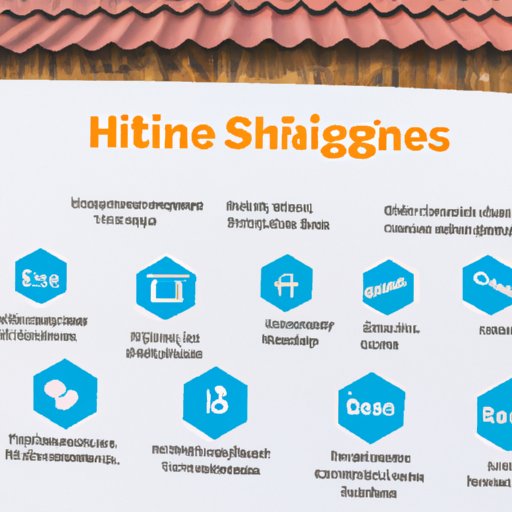Introduction
Shingles is a viral infection that is caused by the same virus responsible for chickenpox: the varicella zoster virus. It is characterized by a painful rash that often appears in a band-like pattern along one side of the body and typically lasts two to four weeks. Shingles can also cause fever, headache, chills, and fatigue. Although it is not life-threatening, it can be very painful and cause long-term nerve damage.

Exploring the Causes and Symptoms of Shingles
The varicella zoster virus is part of a family of viruses called herpesviruses, which includes the viruses that cause cold sores, genital herpes, and mononucleosis. The virus remains in the body after a person has had chickenpox, but it lies dormant (inactive) until something triggers it to reactivate. Once the virus is reactivated, it travels along nerve pathways to the skin, causing the characteristic rash and other symptoms of shingles.
What Causes Shingles?
The exact cause of shingles is not fully understood, but it is believed to be triggered by a weakened immune system, stress, or certain medications. People who are elderly, have cancer, or have HIV/AIDS are more likely to develop shingles because their immune systems are already weakened.
What are the Symptoms of Shingles?
The most common symptom of shingles is a painful rash that appears in a band-like pattern along one side of the body or face. Other symptoms may include fever, headache, chills, and fatigue. The rash typically begins as small, red bumps that eventually turn into blisters. The blisters may ooze fluid and then crust over before healing. The rash usually resolves within two to four weeks.

Understanding the Risk Factors for Shingles
Anyone who has had chickenpox is at risk for developing shingles, but some people are more prone to the condition than others.
Who is at Risk for Developing Shingles?
People who are elderly, have cancer, or have HIV/AIDS are more likely to develop shingles because their immune systems are already weakened. Additionally, people who take medications that suppress the immune system, such as those used for organ transplant patients, are also at increased risk.
What Conditions Increase the Risk of Developing Shingles?
Stress, extreme exhaustion, and diseases that weaken the immune system can all increase the risk of developing shingles. Additionally, people who have recently been exposed to someone with chickenpox are at greater risk of developing the condition.

Learning How to Prevent Shingles
Although there is no guaranteed way to prevent shingles, there are a few things you can do to reduce your risk.
Vaccination as a Prevention Method
The best way to prevent shingles is to get vaccinated. The shingles vaccine is available for people aged 50 and older, and it is recommended for everyone in this age group. The vaccine helps protect against the virus, reducing the risk of developing shingles and its associated symptoms.
Healthy Habits that Can Help Reduce the Risk of Shingles
In addition to getting vaccinated, maintaining a healthy lifestyle can help reduce the risk of developing shingles. Eating a balanced diet, exercising regularly, getting enough sleep, and managing stress can all help boost the immune system and reduce the risk of shingles.
Investigating Treatment Options for Shingles
There are several treatments available for shingles, depending on the severity of the condition.
Medications Used to Treat Shingles
Antiviral medications, such as acyclovir, valacyclovir, and famciclovir, are commonly prescribed to treat shingles. These medications work by attacking the virus, helping to reduce the severity and duration of the symptoms. Pain medications, such as ibuprofen and acetaminophen, can also be used to manage pain.
Home Remedies for Shingles
In addition to medications, there are several home remedies that can help relieve the pain and discomfort associated with shingles. Applying cool compresses to the affected area can help reduce pain and swelling. Taking a lukewarm bath with colloidal oatmeal can also help soothe the skin. Finally, applying aloe vera gel or calamine lotion to the affected area may help alleviate itching.
Examining the Long-Term Effects of Shingles
Although most cases of shingles resolve without any long-term effects, some people may experience complications.
Complications of Shingles
The most common complication of shingles is postherpetic neuralgia, which is a condition characterized by persistent pain in the area where the rash appeared. This pain can last for months or even years. Other possible complications include skin infections, vision loss, and neurological problems.
Postherpetic Neuralgia
Postherpetic neuralgia is a condition that affects up to 20% of people who have had shingles. It is characterized by persistent pain in the area where the rash appeared. This pain can be mild or severe, and can last for months or even years. Treatment typically involves medications, such as tricyclic antidepressants, anticonvulsants, and lidocaine patches.
Conclusion
Shingles is a viral infection caused by the varicella zoster virus. It is characterized by a painful rash that often appears in a band-like pattern along one side of the body and typically lasts two to four weeks. Anyone who has had chickenpox is at risk for developing shingles, but the risk increases for people who are elderly, have cancer, or have HIV/AIDS. The best way to prevent shingles is to get vaccinated. Treatment typically involves antiviral medications and over-the-counter pain medications. In some cases, long-term complications can occur, including postherpetic neuralgia. If you think you may have shingles, contact your doctor for diagnosis and treatment.
For more information about shingles, visit the Centers for Disease Control and Prevention website at https://www.cdc.gov/shingles/.
(Note: Is this article not meeting your expectations? Do you have knowledge or insights to share? Unlock new opportunities and expand your reach by joining our authors team. Click Registration to join us and share your expertise with our readers.)
